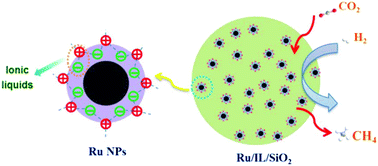当前位置:
X-MOL 学术
›
Green Chem.
›
论文详情
Our official English website, www.x-mol.net, welcomes your feedback! (Note: you will need to create a separate account there.)
Ru nanoparticles stabilized by ionic liquids supported onto silica: highly active catalysts for low-temperature CO2 methanation
Green Chemistry ( IF 9.8 ) Pub Date : 2018-09-25 , DOI: 10.1039/c8gc02337a Xinpeng Guo 1, 2, 3, 4, 5 , Zhijian Peng 1, 2, 3, 4 , Atsadang Traitangwong 5, 6, 7, 8, 9 , Gang Wang 5, 6, 7, 8, 9 , Haiyang Xu 5, 6, 7, 8, 9 , Vissanu Meeyoo 5, 6, 7, 8, 9 , Chunshan Li 5, 6, 7, 8, 9 , Suojiang Zhang 5, 6, 7, 8, 9
Green Chemistry ( IF 9.8 ) Pub Date : 2018-09-25 , DOI: 10.1039/c8gc02337a Xinpeng Guo 1, 2, 3, 4, 5 , Zhijian Peng 1, 2, 3, 4 , Atsadang Traitangwong 5, 6, 7, 8, 9 , Gang Wang 5, 6, 7, 8, 9 , Haiyang Xu 5, 6, 7, 8, 9 , Vissanu Meeyoo 5, 6, 7, 8, 9 , Chunshan Li 5, 6, 7, 8, 9 , Suojiang Zhang 5, 6, 7, 8, 9
Affiliation

|
A series of Ru-based catalysts for CO2 methanation at low temperature were synthesized by the dispersion of Ru nanoparticles in different 1-butyl-3-methylimidazolium ionic liquids on a silica support. The effect of various ionic liquids and loadings on the physicochemical properties of the catalysts and the methanation catalytic activity were investigated. The Ru/[BMIM]BF4(1 : 10)/SiO2 catalyst demonstrated the best catalytic performance with CO2 conversion of 70.47% at 250 °C, which was related to the highly dispersed small Ru nanoparticles, basic property, and readily reducible RuO2 species. The results revealed that ionic liquids can not only be used as a protectant to effectively prevent the aggregation and oxidation of the nanoparticles by space resistance and electrostatic protection, but can also be adsorbed on the surface of Ru nanoparticles as a modification layer with strong adsorption to ultimately determine the size of the nanoparticles and maintain high dispersion, which can significantly affect the catalytic activity.
中文翻译:

通过负载在二氧化硅上的离子液体稳定的Ru纳米颗粒:用于低温CO 2甲烷化的高活性催化剂
通过将Ru纳米颗粒分散在二氧化硅载体上的不同的1-丁基-3-甲基咪唑鎓离子液体中,合成了一系列用于低温CO 2甲烷化的Ru基催化剂。研究了各种离子液体和负载量对催化剂理化性质和甲烷化催化活性的影响。Ru / [BMIM] BF 4(1:10)/ SiO 2催化剂在250°C时表现出最佳的催化性能,CO 2转化率为70.47%,这与高度分散的小Ru纳米颗粒,基本性质和易得性有关。可还原RuO 2物种。结果表明,离子液体不仅可以作为保护剂通过空间电阻和静电保护有效地防止纳米颗粒的聚集和氧化,而且还可以作为改性层吸附在Ru纳米颗粒的表面,并具有很强的吸附力。最终确定纳米颗粒的大小并保持高分散性,这可能会显着影响催化活性。
更新日期:2018-10-30
中文翻译:

通过负载在二氧化硅上的离子液体稳定的Ru纳米颗粒:用于低温CO 2甲烷化的高活性催化剂
通过将Ru纳米颗粒分散在二氧化硅载体上的不同的1-丁基-3-甲基咪唑鎓离子液体中,合成了一系列用于低温CO 2甲烷化的Ru基催化剂。研究了各种离子液体和负载量对催化剂理化性质和甲烷化催化活性的影响。Ru / [BMIM] BF 4(1:10)/ SiO 2催化剂在250°C时表现出最佳的催化性能,CO 2转化率为70.47%,这与高度分散的小Ru纳米颗粒,基本性质和易得性有关。可还原RuO 2物种。结果表明,离子液体不仅可以作为保护剂通过空间电阻和静电保护有效地防止纳米颗粒的聚集和氧化,而且还可以作为改性层吸附在Ru纳米颗粒的表面,并具有很强的吸附力。最终确定纳米颗粒的大小并保持高分散性,这可能会显着影响催化活性。



























 京公网安备 11010802027423号
京公网安备 11010802027423号